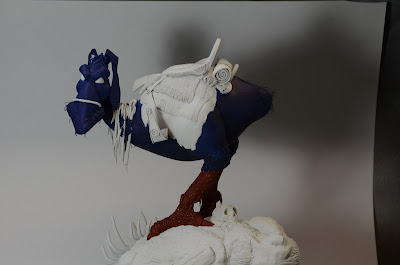These four show the progress that had been made since the start in 2014. Things come up and modelling gets put aside, that's life.
Obviously the whole thing is nearly complete except for some details such as a coil of rope, a sword and scabbard and a waterbottle. The stirrups are lead sheet as are the arm wrappings and decoration on the rifle. Reins are braided thread and the ears and saddle are Worbla (a material used in costume making which can be moulded to conform to simple shapes on the application of heat from a heat gun). All the main parts are Apoxie Sculpt even down to the ribcage, the rock covering and the base. When I put the rider in place, the balance of the whole seemed out a bit so I raised one side by making the black plastic edging higher and that fixed everything.
Painting starts with a layer of Citadel Corax white which disappointed me in that it dried quite dusty and pebbly unlike the old Skull white which it replaced.It could have the application or the conditions but all the pieces required a deal of attention to get them smooth for the subsequent layers, a real pain. Because I would be painting bright colours, reds,yellows and blues, the undercoat needed to be as light as possible.
Using a combination of Citadel and Vallejo acrylics the beast became a riot of colour. Very rarely do I choose such bright tones but this subject required them and I must admit it was a pleasure to use them, certainly a change from my normal Nurgle palette of greens and greys. Washes,inks and glazes all got a workout and the legs particularly benefitted from their application.
You might notice some bum and muzzle hairs which were such fun to put in one at a time- phew!
The rider got the same treatment of colour application, from a dark base to lighter layers up to the highlights. The rifle was masked as it would require very careful painting with fine brushes while the figure was airbrushed from a vertical position to simulate overhead sun.
Here is a closeup of our hero to show the complexity of the rifle even without the curly wire coils at the top. He is missing the arm bands which were made from strip lead and were such fun to stick in place. I'm not going to go into detail about the hands, suffice it to say that the next creature I sculpt will either be an amputee or have hoofs! That left hand had to hold the reins and each one had to be made to fit into slots at the thumb and the base. It would have been good to know something like that had better been planned for, before they were attached.
As is my usual practice, I like to see the thing come together even if it is not quite there yet. I think I am convincing myself that there is an end in sight and that with just a bit more work it'll all be finished soon. That base had other ideas and required a multitude of layers,drybrushing, washes and a fun filled application of a blood pool (which would not set, and shrank and dribbled and made a hell of a mess altogether).
As anyone who knows this picture by William Stout, it has a strong yellow background with orange and white shadings and streaks, together with a couple of flying creatures. I could not do the whole job justice without trying to emulate the true scene and here she be! And there's the waterbottle! That's mine alone.
DIMENSIONS: Height 36cm Base 25x13cm
PS If you are interested in the beginnings of this build, go to the entry for 25th July 2014. I had to because I didn't know what condition I'd left the poor thing in.
























































